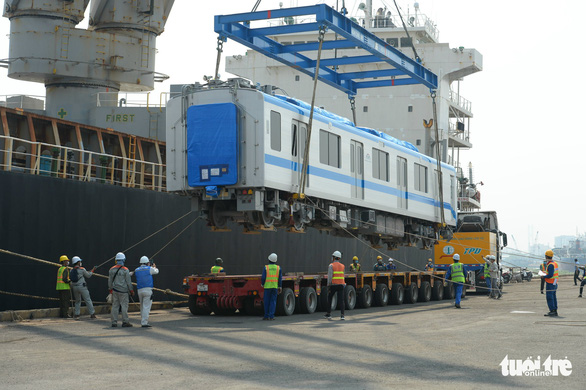The twelfth and thirteen trains of Ho Chi Minh City’s metro line No. 1 have arrived at a seaport in the Vietnamese southern metropolis after a journey from the Kasado Port in Japan.
After reaching the Khanh Hoi Port at 10:00 am on Friday, the trains were moved to specialized vehicles for transport to Long Binh depot in Thu Duc City for trial operations.
Thirty engineers and workers were mobilized to the port for handling the carriages, according to the Saigon Port Handling Services JSC.
 |
| This photo shows one of the six metro cars being craned out of a ship at the Khanh Hoi Port in Ho Chi Minh City on March 11, 2022. Photo: Tu Trung / Tuoi Tre |
Similar to the Japanese-manufactured trains delivered before, these two trains, consisting of three cars each, have their covers made of aluminum alloy and painted mainly in blue.
Each train is 61.5 meters long and can carry 930 passengers, including 147 seating and 783 standing guests.
The city’s first metro line is 19.7 kilometers long, including 2.6 kilometers of underground railways and 17.1 kilometers of elevated tracks.
It runs from Ben Thanh Market in District 1 to Suoi Tien Theme Park in Thu Duc City through three underground stations and 11 stops above the ground.
 |
| Some of the 30 engineers and workers are seen handling the two metro trains delivered to the Khanh Hoi Port in Ho Chi Minh City on March 11, 2022. Photo: Tu Trung / Tuoi Tre |
The line is designed to have 17 trains, with 51 cars in total, and can run at up to 110 kilometers per hour above ground and 80 kilometers per hour underground.
The first train was delivered to the port on October 8, 2020.
The four remaining trains are expected to arrive at the same port within this month, said Hoang Mai Tung, deputy director of the Project Management Unit No. 1 under the city’s Management Authority for Urban Railway (MAUR), the project investor.
Nearly 89 percent of the workload of the metro line project, which started in August 2012, has completed so far, MAUR said.
The project was previously expected to be completed by the end of last year, but the COVID-19 pandemic has posed a lot of difficulties to the arrival of experts and the import of equipment, which has slowed down the overall progress.
Tung said MAUR and the contractors will try their best to put the line into operation in late 2023, the Vietnam News Agency reported.
The project costs more than VND43.7 trillion (US$1.92 billion), most of which comes from Japan’s official development assistance (ODA) aid.
Like us on Facebook or follow us on Twitter to get the latest news about Vietnam!




















































